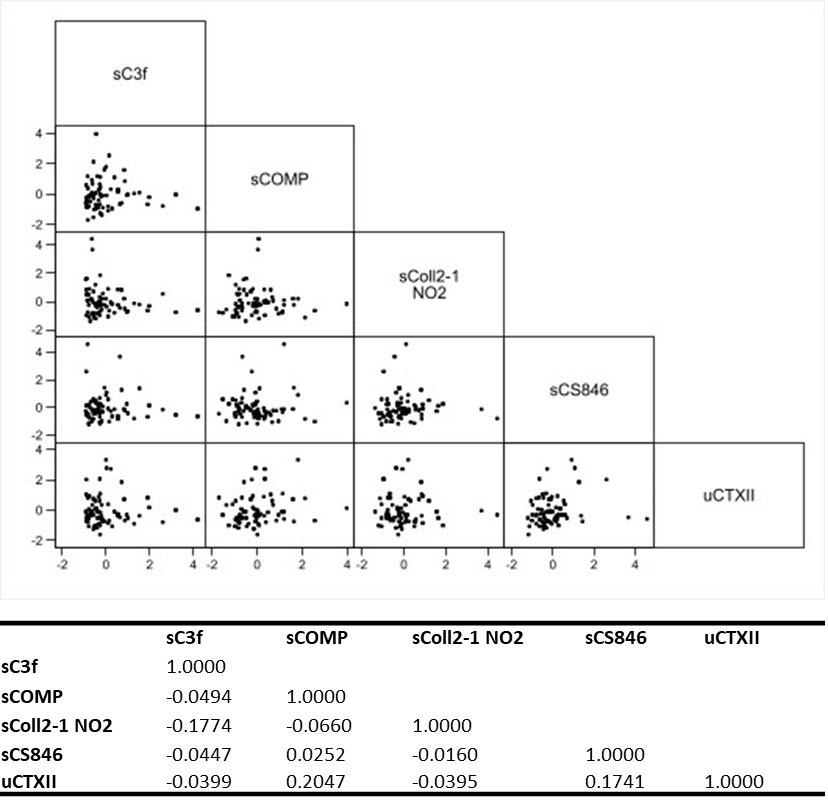Session Information
Session Type: Poster Session A
Session Time: 1:00PM-3:00PM
Background/Purpose: C3 complement fragment (C3f) has been identified as a potential biomarker for evaluating osteoarthritis (OA). C3f is released during the catabolic degradation of C3b by factor H upon C3 activation. It was first identified using surface-enhanced laser desorption/ionization time-of-flight mass spectrometry (SELDI-TOF-MS) and the peak intensities of serum C3f were higher in OA subjects compared to controls [1, 2]. Apart from our studies of C3f in Bristol OA cohorts, there have been no studies of this biomarker in independent cohorts, and its value as a marker of OA still remains unknown. The purpose of this study was to determine the associations of C3f with clinical, radiographic, and biochemical markers of knee OA using an independent cohort of OA patients from the National Institute of Health Osteoarthritis Initiative (OAI).
Methods: We used the OAI cohort for evaluating serum C3f (sC3f). Four hundred and fifteen participants were selected and had baseline sC3f measured using ion-trap chromatography. We carried out a patient-level analysis, using the worst affected knee. The outcome measures used in this study included: K&L grade, WOMAC pain and stiffness, Joint space narrowing (JSN) medial and lateral OARSI grades, Joint space width (JSW), osteophytes medial and lateral OARSI grades. Univariate and multivariate logistic and linear regression modelling was used to assess the association of sC3f with the outcomes. Pearson correlation was used to evaluate the correlation of sC3f with 4 selected OA biomarkers (COMP, CS846, CTXII, Coll2-1 NO2) which have been identified as clinically useful [3]
Results: sC3f was found to be negatively associated with K&L grades (Odd Ratio (OR) 0.9922 (95% CI: 0.9868, 0.9976) p-value: 0.026) and JSN medial (OR: 0.9914 (95% CI: 0.986, 0.9968) p-value: 0.012) in adjusted models (Table 1). Out of the 418 subjects, 68 participants had sC3f, sCOMP, sCS846, sColl2-1 NO2 and uCTXII measurements. To evaluate the correlation of sC3f and with the 4 more established biomarkers, Pearson correlation was used and found that there was no linear relationship between sC3f and each biomarker (Figure 1). The data suggest that all biomarkers are independent of one another which can provide additional predictive power.
Conclusion: Our data suggest that C3f could be a marker of structural changes in OA and therefore may be useful for evaluating disease activity in OA. C3f was not correlated with other established biomarkers suggesting that different pathways are involved in OA pathology.
References
1. Cobraiville, G., et al., Validation of a new method by nano-liquid chromatography on-chip tandem mass spectrometry for combined quantitation of C3f and the V65 vitronectin fragment as biomarkers of diagnosis and severity of osteoarthritis. Talanta, 2017. 169: p. 170-180.
2. de Seny, D., et al., Discovery and biochemical characterisation of four novel biomarkers for osteoarthritis. Ann Rheum Dis, 2011. 70(6): p. 1144-52.
3. Liem, Y., et al., Multivariable logistic and linear regression models for identification of clinically useful biomarkers for osteoarthritis. Sci Rep, 2020. 10(1): p. 11328.
To cite this abstract in AMA style:
Liem Y, Judge A, Ourradi K, de Seny D, Li Y, Sharif M. Associations of Serum C3f with Selected Biomarkers and Radiographic and Clinical Features of Knee Osteoarthritis [abstract]. Arthritis Rheumatol. 2022; 74 (suppl 9). https://acrabstracts.org/abstract/associations-of-serum-c3f-with-selected-biomarkers-and-radiographic-and-clinical-features-of-knee-osteoarthritis/. Accessed .« Back to ACR Convergence 2022
ACR Meeting Abstracts - https://acrabstracts.org/abstract/associations-of-serum-c3f-with-selected-biomarkers-and-radiographic-and-clinical-features-of-knee-osteoarthritis/


